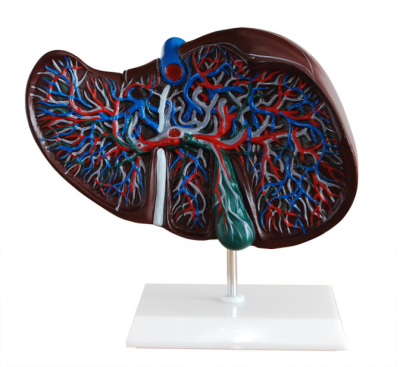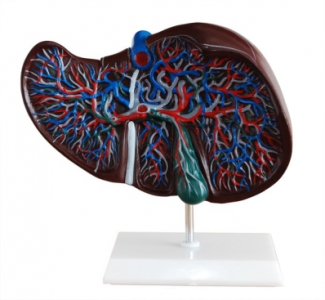In terms of liver function, although the liver anatomical model can not directly show its complex biochemical process, it can indirectly convey the main function of the liver through its structural characteristics and design details. The following is a detailed explanation of how the liver function is represented in the anatomic model of the liver:

Structural characteristics of liver:
Liver anatomical models are often designed as irregular wedges to simulate the true shape of the liver. The model usually shows the right and left lobes of the liver and the dividing line between them. This design not only shows the appearance of the liver, but also hints at its status as the body's largest internal organ.
The model also shows the major blood vessels and bile duct systems of the liver, such as the hepatic artery, portal vein, hepatic vein, and intrahepatic bile duct. These structures are important channels for substance exchange and metabolism in the liver, and their location and distribution in the liver can be intuitively understood through the model.
Basic functional units of the liver:
Anatomical models of the liver usually show the lobule, the basic functional unit of the liver. The liver lobule is a tiny structure composed of many liver cells and liver blood sinuses, which is the basic unit of liver metabolism and detoxification. Through the liver lobular structure on the model, it can help students and doctors better understand the microstructure and function of the liver.
Manifestation of metabolic function:
The liver is an important metabolic organ of the human body, involved in the metabolism of proteins, sugars and fats. Although the anatomic model of the liver cannot directly demonstrate these metabolic processes, it can suggest these functions through its structural characteristics and design details. For example, structures such as hepatic lobules and hepatic sinuses shown on the model hint at the role of the liver in material exchange and metabolism.
Detoxification and coagulation function:
The liver has a powerful detoxification function, able to remove harmful substances and microorganisms from the blood. The vascular and bile duct system of the liver shown in the model, as well as liver cells and sinuses in the hepatic lobules, suggest an important role of the liver in the detoxification process. In addition, coagulation factors and other structures labeled on the model also reflect the role of the liver in coagulation function.
Application in teaching and practice:
By observing and studying liver anatomical models, students and physicians can gain a deeper understanding of the structure and function of the liver. This intuitive way of learning helps them better understand and master liver-related medical knowledge, laying a solid foundation for future clinical practice.

